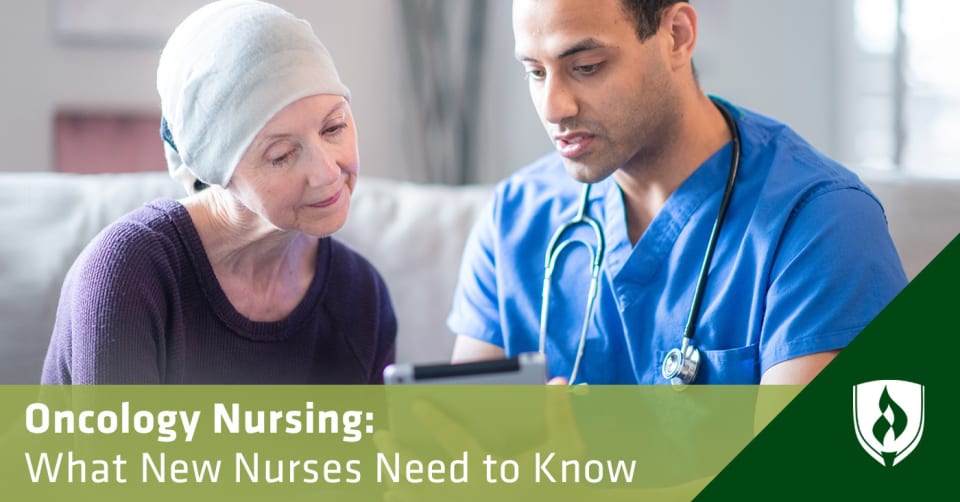
Facing cancer every day as an oncology nurse takes a mix of both strength and knowledge. Cancer is an ugly enemy, and currently the second-leading cause of death in the world. Though efforts for early detection and improvements in treatment have helped improve patient outcomes, nurses still deal with the effects of cancer on their patients’ quality of life and the psychological impact of both diagnosis and treatment. Oncology patients, at the same time, often wrestle with redefining what a “normal” life means for them while also dealing with physical pain and often, overwhelming fatigue.
Oncology nurses have the privilege of walking with these patients through the intertwined emotional and physical challenges that cancer brings. Oncology nurses can help relieve patients’ pain and nausea and assist with implementing the treatment plan that is best for the patient.
If you’re interested in oncology nursing, chances are good that you already know a little about the field. In this article, we’ll cover both the basics of the job and get first-hand insights from oncology nurses in a variety of settings.
Get Your Nursing School Questions Answered at a Nursing Information Session
What does an oncology nurse do?
Oncology nurses are registered nurses who specialize in working with patients with cancer and patients in remission. They have a deep knowledge of cancer’s pathology, treatments and pain management. Oncology nurse roles can vary from specializing in bone marrow transplantation to a focus on cancer screening, detection and prevention in the community.
No matter where they work, oncology nurses generally have the following responsibilities:
- Patient assessment: Noticing the patient’s physical and emotional status, conducting a health history and assessing the patient’s and family’s knowledge of the disease and treatment
- Patient education: Making sure the patient is participating in the decision-making process, understands the diagnosis and treatment, and knows what to do in an emergency
- Coordination of care: Documents the care given, keeps in contact with the patient and their family through the course of treatment via phone and helps with any referrals needed
- Direct patient care: This often includes administering chemotherapy, but also includes taking labs, maintaining central lines and administering medications
- Patient symptom management: Evaluates patient needs and deploys measures to relieve nausea, vomiting, pain and fatigue
- Supportive care: Promotes patient comfort and alleviates side effects of pharmacologic therapies
While performing their job duties, oncology nurses build strong relationships with their patients. Since oncology patients often need frequent appointments and longer-term care, oncology nurses can really build special relationships with their patients. “To oncology patients, you are not just a nurse. You walk alongside them from day 1 to ringing the bell when they are done with treatment,” says Megan Arriola, Oncology Nurse and blogger at Mighty Nurse Megan.
Where do oncology nurses work?
Oncology nurses can work in a few different settings—the primary categories being oncology floors in hospitals or in outpatient oncology clinics. 43 percent of Oncology Nursing Society (ONS) members work in a hospital/multihospital system, 24 percent work in an outpatient/ambulatory care center.1 Oncology nurses can also work in a physician office (11 percent) or for in-home healthcare agencies (3 percent).1
Working in a hospital or outpatient setting can come with a lot of variety. Let’s breakdown those two categories.
Hospital oncology floor
Oncology nurses in a hospital setting usually work on the oncology floor. Nurses on the oncology floor may be caring for patients who recently had surgery, are undergoing chemotherapy or are simply very sick. They often have to be very familiar with central lines, blood products and common laboratory test result thresholds.
Oncology patients need lots of care and attention. Their condition can deteriorate quickly, often into some kind of shock, so nurses must watch carefully for new signs and symptoms, chest pain, a new fever or extreme pain. Oncology nursing in a hospital setting can be very demanding, but nurses on the floor get the privilege of helping to relieve patients’ pain and helping them walk through a challenging time.
Oncology outpatient clinic
Outpatient oncology clinics can involve the care of patients in all stages of their journey from remission to new oncology consults where nurses can take health histories and perform labs.
Outpatient oncology clinics can also include the administration of chemotherapy or other infusions. Arriola, who works as an infusion nurse, cares for patients who need therapies like chemotherapy, hydration, electrolyte replacement, Crohn’s infusions, port flushes and daily antibiotics. These can take anywhere from 30 minutes to eight hours. “It’s a great way to truly be involved in cancer care,” says Arriola.
While this may vary by employer, nurses in outpatient clinics generally work 8- or 9-hour shifts, while those working on oncology floors often work 12-hour shifts—with fewer days “on” to balance it out.
What you should know before becoming an oncology nurse
Now that we’ve got the basics of oncology-focused nursing roles down, let’s explore what oncology nurses think you should know before getting started on this career path.
1. You’ll develop strong relationships with your patients
Because oncology patients generally spend more time admitted to the hospital and nurses spend the most time with patients, the relationships you build with them will be special. “Oncology patients are the most loving and selfless patients I have experienced,” says Arriola.
You’ll walk through difficult milestones—from beginning chemotherapy and the joy of remission or ending their fight with dignity. Not only will you build strong relationships with them, they’ll inspire you. Oncology patients work as hard as they can to feel better.
“I always said that I was helping those patients through something devastating and scary. But, it turns out they helped me understand that life is precious and I should live every day to the fullest,” says Jennifer Bhatia, an APRN who worked in oncology for over 30 years.
2. You’ll have to take care of yourself, too
While the oncology nurse and patient relationship can be extremely rewarding, it can also be difficult to manage the fact that your work will require seeing these people at some of their lowest moments. The emotional blow of losing a patient you’ve cared for many times can be devastating. Seeing patients in pain, regularly vomiting and surrounded by anxious families can be taxing as well. No matter what kind of nursing you pursue, it’s important to take care of yourself so you can return to work for your next shift and give 100 percent to those patients as well.
Take time to connect with your team as they will relate to what you’re going through. Finding time to journal about experiences that you may not be able to share with family members to protect patient privacy can help as well.
Rest is important to avoiding burnout and creating a career you love. “I would tell my younger self to get your rest and take care of yourself. Enjoy every minute of your career and life,” says Bhatia.
3. You’ll use both your medical knowledge and emotional intelligence
Oncology nursing takes not only the emotional intelligence to deal with loss and patients’ physical and emotional pain, but also the medical knowledge that will allow you to do everything you can for your patients. You will need an understanding of disease process, physical effects and treatments offered to the patient.
As patients progress through their treatment, different emotions will arise. “You will need an equal knowledge of the emotional effects as they’re going through the most challenging experience of their life,” notes Bhatia. Patients are often scared, upset and anxious and it’s important to understand how their emotions are playing a role in their health, and how to talk about them with both the patient and the patient’s doctor.
How to become an oncology nurse
The first step is to become a registered nurse (RN) by obtaining either an Associate’s Degree in Nursing (ADN) or a Bachelor of Science in Nursing (BSN) and obtaining state licensure. No matter which degree you choose, once you’ve become a registered nurse, you’ll be qualified to apply to oncology RN positions—though having some nursing experience before applying will certainly help. Ideally this experience can be gained while working as a “floating nurse” as an RN. Another option would be to build experience on an oncology floor as a certified nursing assistant before or during nursing school.
No matter how much prior experience you have, you will learn a lot on the oncology floor. You’ll learn how to calculate and infuse chemotherapy treatments, manage side effects, and perform blood and platelet transfusions. “The oncology floor taught me so much about patient care,” Bhatia says.
Oncology nursing skills
Before getting into oncology, it’s a good idea to take note of what nursing skills you’ll use more frequently. Oncology nurses need to be detail-oriented as chemotherapy medications are weight based and specific to each patient. They also work a lot with central lines and need to be familiar with common complications, how to draw blood and how to do central line dressing changes.
Cancer is a complicated disease with often complex treatment plans. It can be easy for patients to forget or get confused so it’s important for nurses to educate patients about their diagnosis and treatment plan in clear terms. Oncology patients often get to know more medical jargon than the average patient, but between the “brain fog” that often accompanies chemotherapy and the fatigue, oncology nurses need to put in an emphatic effort to confirm the patient understands what’s going on with their health.
Not only will you be educating patients as oncology nurse, you’ll also be learning. Oncology is always changing and your knowledge has to grow with it. “You will learn something new every day,” says Bhatia.
Oncology nursing certifications
As with many other nursing specialties, this nursing focus area offers opportunities to earn professional certification. The Oncology Certified Nurse (OCN) offering from the Oncology Nursing Certification Corporation is a prominent option for experienced oncology nurses. This certification requires an extensive test and proof of work experience to verify your oncology nursing knowledge.
While obtaining certification may not be required for all positions, it can be a good way to bolster your nursing resume. Though this certification isn’t available to those without oncology experience as an RN, Arriola recommends that new grads consider taking the Oncology Nursing Society’s introductory course, Cancer Basics to demonstrate their interest in this nursing specialty.
Do you have a future in oncology nursing?
Oncology nursing is a unique blend of some of the most challenging emotional and complicated cases you might find in the hospital. If your heart goes out to oncology patients and you want to be there during some of their most difficult moments, oncology might be the right specialty for you. “They say oncology nursing chooses you since most would hesitate to choose to enter into a field where so many unknowns occur daily,” says Bhatia.
If you’re ready to start down your path of becoming a registered nurse, begin with our article “How to Become a Registered Nurse: Your 4-Step Guide.”
Though you certainly don’t have to choose a specialty before becoming an RN (or even after), if you’re intrigued by the variety of specialties RNs can work in and want to discover more, check out our article “Top 25 Types of Nurses Employers Are Looking to Hire.”
Related Articles:
- What I Wish I Knew Before Working in Hospice Nursing
- Radiology Nursing: Exploring Its Role in Diagnosis and Treatment
1Holland-Frei Cancer Medicine 6th Edition, Role of the Oncology Nurse https://www.ncbi.nlm.nih.gov/books/NBK13570/ [accessed October 2020]




